
Abstraction:
non figurative art: art in which the depiction of objects in nature is
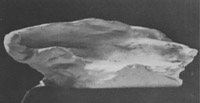 subordinated
or entirely discarded.
subordinated
or entirely discarded.
Abstractionnisme: art non figuratif. Il ne cherche pas à représenter le réel.
Alabaster: soft, fine grained translucent stone: white or pastel coloured gypsum, often with streaks of deeper colour: breaks and scratches easily.
Albâtre: variété de gypse d'un blanc immaculé utilisée pour sculpter de petits objets.
Allegorical figure:
personification or representation
which symbolizes a concept such as Love, Heroism, Death, War, Victory
etc.
Allégorie: figure peinte ou sculptée représentant
une idée abstraite: la Mort, le Jour, la Justice, etc.
Alloy: mixture of metals that usually benefits from the best qualities of each of the separate ingredients..
Alliage: combinaison d'éléments (métalliques ou non) à un métal de base et qui présente les caratéristiques de l'état métallique.
Architectural
sculpture: an integral part of a building or sculpture created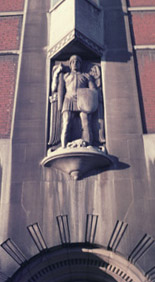 especially to decorate or embellish an architectural structure.
especially to decorate or embellish an architectural structure.
Sculpture décorative:
conçue pour s'intégrer
à un édifice, un monument, etc et qui s'accorde en tant
que lignes et effets avec la portion d'édifice.


Sculpture ornementale: représentant les motifs conventionnels, stylisés.
Armature:
support, frame or structure upon or around which a sculptural form may
be built: the armature for a single sculpture may be constructed out of
many  different
materials such as metal, wood, or plastic, sometimes with small pieces
suspended from wires (called papillons).
different
materials such as metal, wood, or plastic, sometimes with small pieces
suspended from wires (called papillons).
Armature: Ensemble d'éléments destinés à accroître la rigidité d'une pièce ou d'un ouvrage. Charpente en fer ou en bois qui sert à soutenir intérieurement l'oeuvre

Bas relief: the lowest degree of relief, in which all the carving lies within the hollowed-out area below the surface plane, and through an illusion of depth and roundness, looks like raised relief. See also Relief.
Bas relief: sculpture faisant peu saillie par rapport au bloc qui lui sert de support. Voir aussi Relief.
Bozzetto see/voir Maquette.
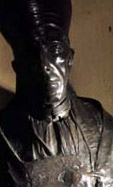 Bronze: metal alloy that combines tin and
copper: Bronze has been used in sculpture for over five thousand years.
See also Casting.
Bronze: metal alloy that combines tin and
copper: Bronze has been used in sculpture for over five thousand years.
See also Casting.

Bronze: alliage de cuivre et d'étain. Bronze était le premier métal utilisé en sculpture, connu depuis c.3000 a.c. Voir aussi Fonte.
Bust: sculpted portrait
or representation consisting of head and part of shoulders.
Buste: peinture, sculpture représentant la tête et
la partie supérieure du corps humain.
 Carving: subtractive process, direct method: cutting of a shape,
figure or design out of a solid material such as a block of stone or wood:
cutting away material. An indirect method of carving used since the 19th
century makes use of a pointing machine (See Pointing).
Carving: subtractive process, direct method: cutting of a shape,
figure or design out of a solid material such as a block of stone or wood:
cutting away material. An indirect method of carving used since the 19th
century makes use of a pointing machine (See Pointing).

Taille: sculpture sur bois: taille direct; travailler, tailler, orner
avec ciseau, etc. dans une matière dure.
Casting:
additive process, indirect method: 1. reproducing a sculptural
form: usually refers to pouring liquid plaster, metal or glass into a
mould where it hardens, in contrast to pressing a more solid material
into a mould (which is called moulding)
2. Cire perdue/Lost wax: method of casting
metal or glass in a mould, the cavity of which, (or the positive of the
form) is formed with wax which is then melted or burned off and displaced
by the molten metal or glass: the process of filling space between the
core and mould after the wax layer has been melted off through a vent
when a molten material is poured into the mould: process has been used
since ancient times.
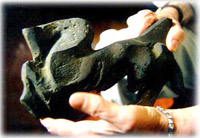 3.
Sand casting: a process of metal casting with foundry sand (refractory
sand with binding qualities) packed around a plaster model or cast to
form a mould or negative of the original sculpture. See also Foundry;
Mould.
3.
Sand casting: a process of metal casting with foundry sand (refractory
sand with binding qualities) packed around a plaster model or cast to
form a mould or negative of the original sculpture. See also Foundry;
Mould.
Fonte:
coulage et moulage; fabriquer un objet avec du métal ou d'alliage
fondu et moulé. On a besoin d'un modèle à vraie grandeur
qui sert à réaliser le moule. 2.
Fonte à cire perdue: modèle en cire est détruite
par réchauffement à 100 c pour permettre à un métal
liquide de prendre sa place. Ce procédé traditionel est
très ancien.
3. Fonte au sable: moulage au sable. Le modèle est retiré
du moule avant la coulée. Dans la méthode traditionelle
le moule est détruite au moment de l'extraction de la sculpture.
Voir aussi Fonderie; Moule.
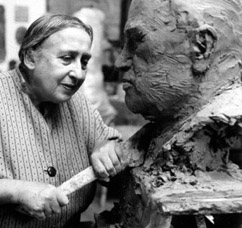 Clay: natural earth material with various applications in sculpture:
a material that can be manipulated or moulded by hand, when moist. It
can be dried in the air or fired in a kiln to make it a permanent relatively
nonporous material: used for the direct process of modelling: clay models
are used for the indirect process of casting.
Clay: natural earth material with various applications in sculpture:
a material that can be manipulated or moulded by hand, when moist. It
can be dried in the air or fired in a kiln to make it a permanent relatively
nonporous material: used for the direct process of modelling: clay models
are used for the indirect process of casting.
Argile: terre onctueuse; impregnée d'eau se transforme en une
pâte imperméable et plastique.
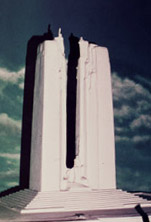 Commemorative
monuments: monuments with local, regional or international political,
cultural or artistic significance: monuments that commemorate a certain
event. See also Monumental.
Commemorative
monuments: monuments with local, regional or international political,
cultural or artistic significance: monuments that commemorate a certain
event. See also Monumental.
Monument commémoratif:
sculpture édifié pour conserver la mémoire d'un grand
événement ou d'une groupe ou d'un individu illustre.
Composition: organization of forms in a work of art: in sculpture, refers principally to the balance and relation of mass, volume, shapes and spaces.
Composition: respectant des principes formels et iconographiques.
Contrapposto: Italian word for "set against." Method developed by the Greeks to represent freedom of movement in a figure. Parts of the body are placed asymmetrically in opposition to each other around a central axis.
Contraposte (Contrapposto): dans le hanchement contrarié; l'épaule placée au-dessus de la jambe qui supporte le corps, ramonte l'axe du torse est incliné dans le sens opposé à celui de la jambe posant
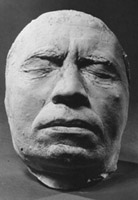 Death mask: cast taken of
a person's face after death. See also Life mask
Death mask: cast taken of
a person's face after death. See also Life mask
Masque mortuaire: relief indépendant du visage d'un mort (moulage sur nature) Voir aussi Masque moulé sur le vif.
Equestrian
statue: sculpture/sculptural groups consisting of horse and rider.
Statue équestre: Statue qui représent un homme ou une femme à cheval.
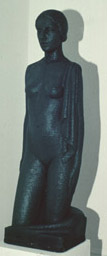 Figurative: referring to the
human form or shape: reproduction of elements as they exist in life, as
opposed to abstraction.
Figurative: referring to the
human form or shape: reproduction of elements as they exist in life, as
opposed to abstraction.
Figuratif: qui représente les formes des objets par opposition à l'art non figuratif.
Figurine (Statuette): sculptural representation of humans or animals at half or less than half life-size.
Figurine: Petite statue d'une hauteur n'excédant pas 25 cm Statuette: Statue mesurant entre 25 et 80 cm de hauteur.
Foundry: Shop where metal sculpture is cast in moulds. Gases given off by molten metals are siphoned off through a series of runners and risers: Furnace temperature for melted bronze is 1010 C. or 1880 F. See also Casting, Mould
Fonderie: atelier où des opérations pour l'exâtion des oeuvres sculptées en métal fondu. Voir aussi Fonte, Moule.
Frieze: wide flat band encircling part or all of a building facade or part of an interior or exterior wall, often decorated with relief carvings or ornamentation.
Frise: surface formant une bande continuée; l'entablement entre l'architrave et la corniche.

Freestanding (in the round): sculpture standing alone, usually
on a pedestal or base: sculpture not attached to a background or wall
(in contrast to Relief).

Ronde bosse: sculpture qui peut être considérée d'autant de pointe de vue qu'il y a de points dans l'espace qui l'environne (par opposition à Relief).
Funerary
sculpture: produced for rituals commemorating the dead or as an individual
expression of grief: sculpture used in, or associated with, the rites
of burial to document, revere, represent and identify the dead such as
Tombstones, effigies, urns, etc.
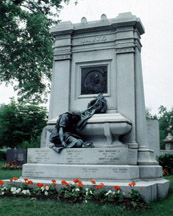
Monument funeraire: élevé à la mémoire d'un mort.
Granite: very hard and durable stone: can average over 350 to 400 million years old and range in colour from black, grey, pale to dark pink, yellow to vibrant red.
Granite: roche crystalline, très dure, noire, blanche, rose ou rouge.
In the round see Freestanding
Life mask: cast of the face or whole head of a living person. See also Death mask
Masque moulé sur le vif: moulage du visage (moulage sur nature). Voir aussi Masque mortuaire
Limestone: sedimentary rock composed of carbonate of lime: a form of calcium carbonate which can be carved on its own or ground up to make plaster when mixed with sand. See also Plaster.
Calcaire: Roche sédimentaire, calcaires tendres ou calcaires durs. Peut être la base du plâtre (q. v.).
Lost wax method: technique of casting. See Casting Cire perdue.
Low relief see Relief
 Maquette (Bozzetto): scale model for large sculpture
or a simple three dimensional sketch of a work.
Maquette (Bozzetto): scale model for large sculpture
or a simple three dimensional sketch of a work.
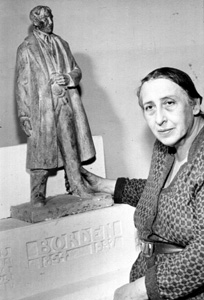
Maquette (Bozzetto): ébauche en réduction d'une oeuvre définitive; modèle à trois dimensions.
Marble: hard, crystalline form of calcium carbonate (hard limestone) capable of taking a high polish. Often white yet can also be various colours, frequently veined with colour. Used for sculpture since ancient times
Marbre: Calcaire cristallin métamorphisé, souvent veiné, dont les colorations variant.
![Frances Loring CNE medal [recto]](images/lexjpgs/fnl0183t.jpg) Medal: small piece of metal (usually gold silver or bronze) bearing
a relief on one or both sides; unlike coins they are cast, not struck
or stamped
Medal: small piece of metal (usually gold silver or bronze) bearing
a relief on one or both sides; unlike coins they are cast, not struck
or stamped

Médaille: Pièce de métal frappée en l'honneur d'un personnage illustre ou commémorant un événement important.
Modelling: additive process, direct method. Manipulation of soft, pliable, malleable material such as clay or wax.
Modelage: Le modelage par adjonction de matière consiste à poser les unes contre les autres des petites portions d'un matériau plastique et à les écraser avec les doigts ou avec un outil. Le modelage par suppression de matière consiste à dégager une forme en creusant progressivement en argile ou en plâtre à l'aide de divers outils comme la spatule.
Modelling clay: 1. any clay which can be modelled or thrown 2. non-hardening clay containing various additives, also known as plastiline. See also Clay
Pâte à modeler: molle, facile à pétrir. La Plastilene était inventée par Tschudi au 20me s. Voir aussi Argile.
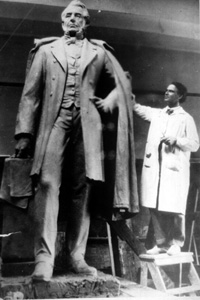 Monumental (monumentality): 1. work that is, or gives the
impression of being large in size or stature; grand, massive and apparently
permanent like a monument, regardless of actual size 2. a work
intended to celebrate and preserve the memory of a person, event or idea
(i.e., a monument to...). See also Commemorative
monument.
Monumental (monumentality): 1. work that is, or gives the
impression of being large in size or stature; grand, massive and apparently
permanent like a monument, regardless of actual size 2. a work
intended to celebrate and preserve the memory of a person, event or idea
(i.e., a monument to...). See also Commemorative
monument.
Monumental: 1. imposant de grandeur, de proportions etc. 2. les ouvrages d'art qu'ils sont intéressant pour la collectivité publique. Voir aussi Monument commémoratif
Mould: hollow (or negative) container used in casting to shape material allowed to harden in it. A typical mould is made of Plaster of Paris: A waste mould can only be used once because it is detroyed when removing the cast. Piece moulds may be reused. See also Casting, Foundry
Moule (Negatif) : corps solide creusé qui donne sa forme à la matière fluide quand elle se solidifié. Voir aussi Fonderie Fonte
Papillion: petits morceaux de bois, assemblés en forme de croix, attachés à des clous ou à l'armature. See Armature
Patina: coating or covering produced by age, such as gloss on wood or green incrustation on bronze: oxidation of bronze or copper through water, chemicals or acids, to produce different surface textures and colours. See also Verdigris.
Patine: certains traitements de surface ou une transformation naturelle (comme la sulfuration à cuivre) qui donne un lustre particuliar. Voir aussi Verdigris.
Plaster: fine white powder, which when mixed with water to a paste or creamy consistency, sets to a hard, cohesive mass: gypsum plaster used for sculpture is called Plaster of Paris because gypsum came from around Paris, France: Plaster, concrete and papier-maché are considered permanent forms of modelling since they do not need to be cast.
Plâtre: détrempé dans l'eau le plâtre forme une pâte plastique utilisée pour la confection des moules, des moulages ou des modelages.
Plastiline Voir Pâte à modeler
 Pointing:
used for the indirect method of carving: transposes strategic measurements
on the surface of sculpture to reproduce, enlarge or reduce it. A pointing
machine has adjustable metal arms which mechanically transfer and/or adjust
measurements from all over the surface of a model to block of wood or
stone. Rodin used this method. Enables skilled workers to carve replicas
of a sculptor's original handmade sculpture.
Pointing:
used for the indirect method of carving: transposes strategic measurements
on the surface of sculpture to reproduce, enlarge or reduce it. A pointing
machine has adjustable metal arms which mechanically transfer and/or adjust
measurements from all over the surface of a model to block of wood or
stone. Rodin used this method. Enables skilled workers to carve replicas
of a sculptor's original handmade sculpture.
Mettre-aux-points: établir des points de repère sur un modèle à trois dimensions et les reporter sur le bloc à tailler pour faciliter le taillage.
Relief: 1. any work in which the figures project from a background. Reliefs are classified by the degree of projection 2. High relief: relief carved deeply enough to suggest parts are almost detached from the surrounding support 3. Low relief: figures that project less than half of their true depth from the background. See also Bas relief.
Relief: 1. ouvrage de sculpture dont le subjet ou certains élé ments font plus ou moins saillie sur un fond plan. 2. Haut relief: sculpture où les figures, preque entièrement de tachées du fond, sont vue dans la quasi-totalité de leur épaisseur 3. Bas relief: dont les différentes formes en saillie, qui adhèrent ou non à un fond plat, convexe ou concave, représentent moins de la moitié du volume réel d'un corps ou d'un objet. Voir aussi Bas relief.
Sand casting see Casting
Statuette see Figurine
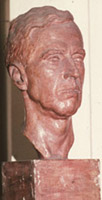 Terra cotta - literally "baked earth" in Italian: unglazed clay
dried in the air and baked or fired: usually red to black, most often
reddish-brown. Terra cotta has been used since neolithic times.
Terra cotta - literally "baked earth" in Italian: unglazed clay
dried in the air and baked or fired: usually red to black, most often
reddish-brown. Terra cotta has been used since neolithic times.
Terre cuite: durcie au feu.
Tin: inexpensive, fusible, corrosion resistant metal which takes a high polish.
Étain: métal blanc, très malléable, fusible. Il fond à 232 șc. Bonne résistance aux agents atmosphériques.
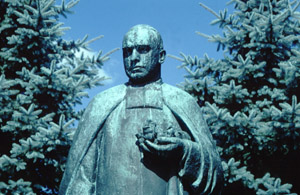 Verdigris(Aerugo): copper or brass rust
which gives a particular green colour to old roofs and bronze statues
and metals which contain copper after exposure to air or acid: valued
for its aesthetic quality: used in medicine and for making pigments. See
also Bronze; Patina
Verdigris(Aerugo): copper or brass rust
which gives a particular green colour to old roofs and bronze statues
and metals which contain copper after exposure to air or acid: valued
for its aesthetic quality: used in medicine and for making pigments. See
also Bronze; Patina
Vert-de-Gris(Vert de Grèce; Aerugo): Carbonate basique de cuivre qui se forme sur les objets (en bronze, etc.) exposés à l'air humide. Voir aussi Bronze; Patine.
War memorials see Commemorative
monuments, Funerary sculpture, Monument.
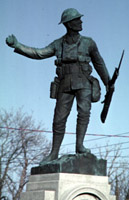
Wax: used for carving, engraving, moulding, modelling and casting because it is sensitive to pressure and a good material for fine detail work: traditional recipes combined beeswax with turpentine, tallow or rosin in varying proportions for various degrees of hardness or malleability.
Cire: matière jaunâtre, molle, connue surtout comme 'etant le produit des abeilles. Utilisée dans les techniques du modelage et du moulage.
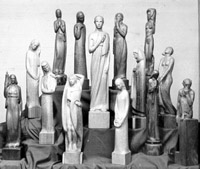 Wood: used for subtractive process of carving (and nowadays for
constructions): may be soft, like cedar and pine; or hard, like boxwood,
mahogany, maple, oak or walnut.
Wood: used for subtractive process of carving (and nowadays for
constructions): may be soft, like cedar and pine; or hard, like boxwood,
mahogany, maple, oak or walnut.
Bois: les bois mous ou tendres sont le pin, le sapin, le cèdre, le saule et le tilleul. Les bois francs ou durs incluent l'érable, l'orme, le chêne, le hêtre, le cerisier, l'acajou et le noyer. La sculpture sur bois était la plus importante tradition au Québec du 17e s. jusqu'au 20e s. Voir Porter, J. R. & Bélisle, J.
Porter, J. R. & Bélisle,
J. La Sculpture Ancienne au Québec. Montréal, Les
Éditions de l'Homme, 1986.
Ministère de la Culture et de la communication, Inventaire général
des richesses artistiques de la France. La Sculpture: Méthode
et Vocabulaire. Paris, Imprimerie Nationale, 1978.
Petit Robert. Montréal, Les Dictionnaires Robert - Canada
S.C.C., 1987.
Reau, Louis. Dictionnaire polyglotte des termes d'art et d'archéologie
Paris, Presses Universitaires de France, 1953.
Bois Cire Verdigris Plâtre Patine Moule Monumental Pâte à modele Maquette Calcaire Masque moulé sur le vif Monument funeraire Ronde bosse Frise Figurine Figuratif Statue équestre Masque mortuaire Contraposte Composition Monument commémoratif Argile Fonte Fonte à cire perdue Fonte au sable Taille Buste Bronze Bas relief Armature Sculpture décorative Sculpture ornementale Alliage Allégorie Albâtre Abstractionnisme


